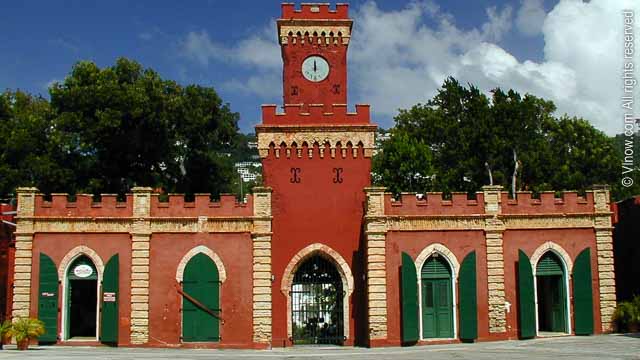The people of French heritage who came from Saint-Barthelemy beginning in the mid-seventeen hundreds, to reside in the Virgin Islands, brought with them all of their treasured customs and traditions.
One of the most treasured traditions was the preparation of their homes and persons for the arrival of Christmas. For the early arrivals from Saint-Barthelemy, Christmas was a time of special activities, filled with joy and hope.
Every year in November, when suddenly the winds started blowing from the North, the inhabitants of the village at the Carenage, and the settlers of the farming community on the Northside of St. Thomas, took a deep breath to inhale the invigorating breezes which they called the fragrant Christmas breeze. After that, life took on an urgency of activity.
In every home of the French communities, the Christmas breeze was the signal to start the general cleaning of the homes, inside and out. The walls were scrubbed and painted. New drapes and curtains were made and hung. New decorations were put all over the house. In the early days, and in some homes, even lately, crepe paper flowers were made into bouquets and garlands of crepe paper frills are hung from rafters or from the ceilings.
The activities accelerated as the time got closer to Christmas week. The air was filled with the fragrant aromas of vanilla, cinnamon, and anise. Christmas is the time for guavaberry liqueur and anisette.
There was shopping for new clothes and shoes for the whole family. Now was the time to spend those funds which had been jealously guarded during the whole year, for this purpose. As children, my siblings and I always marveled at the sudden, miraculous appearance of money, when all year long no matter how we pleaded, we were always told that there was no money for this and no money for that.
Christmastime was a time of constant activity and surprises. Wide-eyed little children were taken into town on December 23rd where they stared at the fabulous decorations and toys in the shop windows. They wondered if Father Christmas or Pere Noel would bring any toys for them on Christmas Eve.
There was also the food and its preparation. Hams were soaked to remove most of the salt. Guavaberry liqueur, Creme de Menthe and Anisette drinks had to be prepared. Nuts, candy, especially the candy that came in little wooden tubs, and big red apples made their entrance. Two days before Christmas the sweetbreads were baked, as was a special sweet potato pudding-pone, a tradition also brought from Saint-Barthelemy in the mid-1800s. This pudding was baked in a pit much like suckling pigs are done.
Everything else accomplished, it was time for personal grooming. Men and boys got their hair cut. They also trimmed and cleaned their fingernails like never before. Young ladies and girls washed their hair and curled it, using strips of brown paper. The older ladies never cut their hair, they washed it and rolled it up like a sausage or they braided it and pinned it up.
In the late afternoons there was time for relaxation with a cup of hot cocoa and stories that were told over and over again.
Christmastime was also the most popular time for young couples to become engaged to be married. Usually, on December 23rd, in the early afternoon, the young man’s mother went to the girl’s home with the engagement gifts. These consisted of a set of three ladies’ hankies, a couple sugar cakes and a small vial of cologne, all tied in a man’s kerchief or a bandana. A bouquet of native flowers also accompanied the gift. If the engagement gifts were accepted, the young man came calling on Christmas Eve and the two families accompanied the young couple to Midnight Mass.
On Christmas Eve morning, the Christmas ham was put to boil in a lard pan on an outside wood-fire. Lots of dark brown sugar was added to help neutralize the rest of the salt which had not been washed out from two days of soaking. All the cooking and baking had to be done and ready by mid-afternoon because there must be time to rest and get ready for the Midnight Mass.
After the church services, the families got together to eat slices of ham and sweetbread and to drink hot cocoa. If the families were not in mourning for recently departed relatives, there was singing of Christmas Carols and other songs of joy.
On Christmas Day, early afternoon, all the young people visited the homes of the aunts and uncles, and sometimes the homes of friends. By mid-afternoon, there was much music and dancing. There was also the singing of Christmas carols. Young musicians went from home to home playing the accordion and violin for the entertainment of everyone. Singing and dancing lasted into the early evening.
It did not matter that times were harsh and the people were poor, Christmas was the birthday of the Christ Child and that is what was being celebrated. It was also the time of joy of families being able to forget whatever slights had been experienced during the year. All losses and the harsh living were set aside while families united and enjoyed each other’s company.
Contributed and copyrighted by Anne-Marie Danet. This article and others can be found in her book “Collection of Writings”. Anne-Marie Danet has won many honors for her writing. She has been recognized by the Legislature of the Virgin Islands by Resolution No. 1597 – Bill No 23-0070 signed July 21, 1999. Ms. Danet has also been recognized by the Government of Saint-Barthelemy, FWI and was awarded the Medal of Honor of that Government. For more information on Ms. Danet’s research and writings visit her web site about French Heritage in the USVI.






